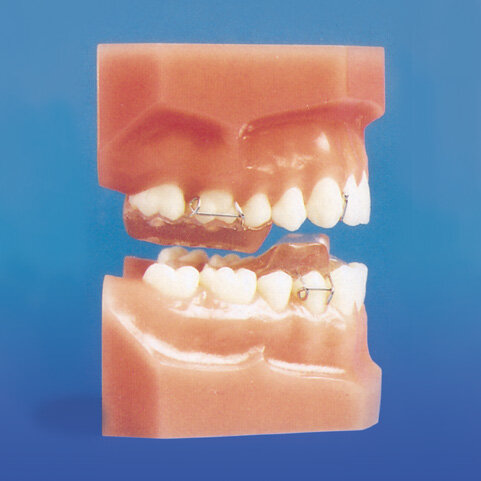Repositioning Of The Mandible & What Happens
Improved clinical use of Twin-block and Herbst as a result of radiating viscoelastic tissue forces on the condyle and fossa in treatment and long-term retention: growth relativity.
Understanding mechanisms of action for orthopedic appliances is critical for orthodontists who hope to treat and retain the achieved corrections in patients with initial Class II mandibular retrognathism. That knowledge can help orthodontists produce clinically significant bone formation and avoid compression at the condyle-glenoid fossa region. It also assists us to understand the differences between short-term and long-term treatment results. It was previously thought that increased activity in the postural masticatory muscles was the key to promoting condyle-glenoid fossa growth. By analyzing results from several studies, we postulate that growth modification is associated with decreased activity, which leads to our nonmuscular hypothesis. This premise has its foundation on 3 key specific findings: significant glenoid fossa bone formation occurs during treatment that includes mandibular displacement; glenoid fossa modification is a result of the stretch forces of the retrodiskal tissues, capsule, and altered flow of viscous synovium; observations that glenoid fossa bone formation takes place a distance from the soft tissue attachment. The latter observation is explained by transduction or referral of forces. Evidence is presented, therefore, that the 3 trigger switches for glenoid fossa growth can similarly initiate short-term condylar growth modifications because the 2 structures are contiguous. These are displacement, several direct viscoelastic connections, and transduction of forces. Histologic evidence further shows that stretched retrodiskal tissues also insert directly into the condylar head's fibrocartilaginous layer. The impact of the viscoelastic tissues may be highly significant and should be considered along with the standard skeletal, dental, neuromuscular, and age factors that influence condyle-glenoid fossa growth with orthopedic advancement. These biodynamic factors are also capable of reversing effects of treatment on mandibular growth direction, size, and morphology. Relapse occurs as a result of release of the condyle and ensuing compression against the newly proliferated retrodiskal tissues together with the reactivation of muscle activity. To describe condyle-glenoid fossa growth modification, an analogy is made to a light bulb on a dimmer switch. The condyle illuminates in treatment, dims down in the retention period, to near base levels over the long-term.
“ significant glenoid fossa bone formation occurs during treatment that includes mandibular displacement; glenoid fossa modification is a result of the stretch forces of the retrodiscal tissues, (stretching of the) capsule, and altered flow of viscous synovium”
- Voudouris and Kuftinec
The posterior, anterior, and lateral attachments of the retro- discal articular disc complex are shown. The condyle is usually guided upward and backward to CR by these and other attachments (from an open jaw position).
When the complex is pulled forward opposite to the direction of the arrows, glenoid fossa modification occurs. Studies have shown that not only the pull of these tissues lead to these changes, the altered dynamics of the synovial fluid facilitates growth beneath the hydrophilic condylar fibrocartilage. In the upper chamber, the opposing anterior flow of synovial fluids similarly influences glenoid fossa growth.
THREE GROWTH STIMULI WORK TOGETHER
Displacement + Viscoelastic tissue pull + Referred Force = Remodeling / Growth of bone in the Glenoid Fossa (along with some growth at the posterior superior aspect of the condyle)
The concept that viscoelastic tissue forces affect growth of the condyle and bone of the Glenoid Fossa suggests that modification first occurs as a result of the action of anterior orthopedic displacement.
Second, both the fossa and the condyle are affected by the posterior viscoelastic tissues anchored between the glenoid fossa and the condyle, inserting directly into the fossa and the condylar fibrocartilage.
Finally, it is hypothesized that displacement and viscoelasticity further stimulate (or turn on the switch for) normal condylar growth by the transduction of forces over the fibrocartilage cap of the condylar head.
Dr. Bakr Rabie Faculty of Dentistry Department of Orthodontics The University of Hong Kong
Typical Effects of Functional Appliances for Class II
Posture the mandible forward
Place some distal driving force on the maxilla
Affect the vertical control of the posterior teeth (usually -Christianson effect)
Detorque the upper incisors
Torque the lower incisors forward
Have some effect on speech and esthetics (this should be a positive effect in the long run)
Do you take jaw joint x-rays before advancing the lower jaw?
It’s an important idea because it allows you to know where the condyle was before being advanced and is referenced to determine whether you are done with the functional aspect of treatment
The main result of a Class II correcting functional appliance is the remodeling of the Temporal fossa
HOW CONDYLAR MODIFICATIONS OCCUR
The growth relativity hypothesis has three main foundations:
A: The glenoid fossa promotes condylar growth with the use of orthopedic mandibular advancement therapy. Initially, that displacement affects the fibrocartilaginous lining in the glenoid fossa to induce bone formation locally.
B: This is followed by the stretch of non-muscular viscoelastic tissues
C: Third, and the most interesting aspect is the new bone formation some distance from the actual retro- discal tissue attachments in the fossa. The glenoid fossa and the displaced condyle are both influenced by the articular disc, fibrous capsule, and synovium, which are contiguous, anatomically and functionally, with the viscoelastic tissues.
HOW CONDYLAR MODIFICATIONS OCCUR
Condylar growth is affected by viscoelastic tissue forces via attachment of the fibrocartilage that blankets the head of the condyle.
Although there is some growth of the condyle, especially at the posterior aspect, the actual amount of growth of the condyle that results from the change in mandibular position is not great.

